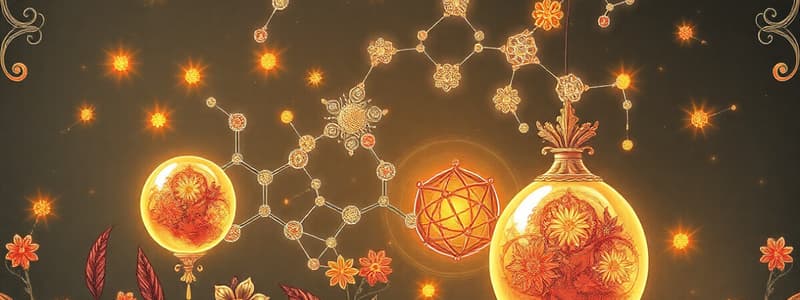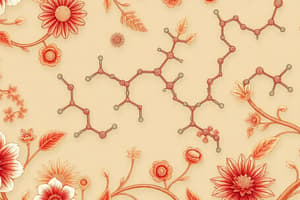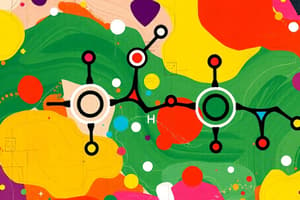Podcast
Questions and Answers
What distinguishes primary, secondary, and tertiary alcohols?
What distinguishes primary, secondary, and tertiary alcohols?
- The presence of additional functional groups in the molecule.
- The type of carbon chain they form.
- The arrangement of hydrogen atoms around the hydroxyl group.
- The number of carbon atoms connected to the carbon with the -OH group. (correct)
Which of the following correctly describes an amide?
Which of the following correctly describes an amide?
- A functional derivative of a carboxylic acid with an amino group replacing the -OH. (correct)
- An organic molecule containing a carbonyl group bonded to two amines.
- A compound containing a -COOH group.
- A nitrogen compound formed by the hydrolysis of an ester.
Which group is present in a ketone?
Which group is present in a ketone?
- A carbonyl group bonded to two carbon groups. (correct)
- A carboxyl group with a nitrogen atom.
- A hydroxyl group attached to a carbon.
- A carbon atom bonded directly to three hydrogen atoms.
What is the correct representation of a functional group?
What is the correct representation of a functional group?
What characterizes carboxylic acids?
What characterizes carboxylic acids?
What type of compound contains an -OH (hydroxyl) group bonded to a tetrahedral carbon atom?
What type of compound contains an -OH (hydroxyl) group bonded to a tetrahedral carbon atom?
Aldehyde contains a carbonyl group bonded to an oxygen.
Aldehyde contains a carbonyl group bonded to an oxygen.
Which of the following describes a carboxylic acid?
Which of the following describes a carboxylic acid?
What group of atoms gives a compound its identity?
What group of atoms gives a compound its identity?
What is the general form of an amine?
What is the general form of an amine?
What is the condensed structural formula?
What is the condensed structural formula?
Organic chemistry is the study of non-carbon compounds.
Organic chemistry is the study of non-carbon compounds.
What type of group is an amino group?
What type of group is an amino group?
Which functional group is distinctively characterized by a -COOH structure?
Which functional group is distinctively characterized by a -COOH structure?
What defines a tertiary alcohol?
What defines a tertiary alcohol?
What distinguishes an amide from a carboxylic acid?
What distinguishes an amide from a carboxylic acid?
What is the key feature of a ketone?
What is the key feature of a ketone?
Flashcards
Alcohol
Alcohol
A compound with an -OH group attached to a carbon atom.
Alcohol Classification
Alcohol Classification
Categorizes alcohols based on bonded carbons to the -OH group (1°, 2°, 3°).
Functional Group
Functional Group
Specific group of atoms that defines a compound's properties.
Carbonyl group
Carbonyl group
Signup and view all the flashcards
Carboxylic Acid
Carboxylic Acid
Signup and view all the flashcards
Study Notes
Alcohol
- Contains an -OH (hydroxyl) group bonded to a tetrahedral carbon atom
- Classified as primary (1°), secondary (2°), and tertiary (3°) based on the number of carbon atoms bonded to the carbon bearing the -OH group
Aldehyde
- Contains a carbonyl group (C=O) bonded to a hydrogen
- Has a -CHO group
Amide
- A functional derivative of a carboxylic acid
- An amino group replaces the -OH of the carboxyl group
Amine
- Organic compound where one, two, or three hydrogens of ammonia are replaced by carbon groups
- RNH₂, R₂NH, or R₃N, where R represents a carbon group
Amine Classification
- Primary (1°), secondary (2°), and tertiary (3°)
- Based on the number of carbon groups bonded to the nitrogen atom of the amino group
Amino Group
- A nitrogen atom bonded to one, two, or three R groups
- RNH₂, R₂NH, or R₃N, where R represents a carbon group
Carbonyl Group
- A C=O group
Carboxyl
- Carbonyl + hydroxyl group
- A -COOH group
Carboxylic Acid
- Contains a -COOH group
Carboxylic Ester
- A derivative of a carboxylic acid
- A carbon group replaces the H of the carboxyl group
- -COOR or -CO₂R
Condensed Structural Formula
- A shorthand method for writing organic structures
- Hydrogens are grouped with the atom they are attached to
Functional Group
- The group of atoms that gives a compound its identity
- Group of atoms within a molecule that shows a characteristic set of predictable physical and chemical behaviors
Hydroxyl (-OH) group
- An -OH group bonded to a tetrahedral carbon atom
Ketone
- Contains a carbonyl group (C=O) bonded to two carbon groups
Organic Chemistry
- The study of carbon compounds
Functional Group Summary
- Hydroxyl Group: A defining feature of alcohols, this group consists of an oxygen atom attached to a hydrogen atom (-OH).
- Carbonyl Group: A crucial component in aldehydes and ketones, this group features a carbon atom double-bonded to an oxygen atom (C=O).
- Carboxyl Group: Found in carboxylic acids, this group is a combination of a carbonyl and a hydroxyl group (-COOH), giving the compound acidic properties.
- Amino Group: Characterized by a nitrogen atom connected to one, two, or three carbon groups (RNH2, R2NH, or R3N). These are key building blocks in amino acids, proteins, and other biological molecules.
Alcohol Classification
- Primary alcohols (1°): Possess one carbon atom attached to the carbon bearing the -OH group.
- Secondary alcohols (2°): Have two carbon atoms bonded to the carbon bearing the -OH group.
- Tertiary alcohols (3°): Feature three carbon atoms connected to the carbon bearing the -OH group.
Aldehyde & Ketone Differentiation
- Aldehydes: Contain a carbonyl group bonded to a hydrogen atom (-CHO).
- Ketones: Feature a carbonyl group linked to two carbon groups.
Amide & Amine Summary
- Amides: Derived from carboxylic acids by replacing the -OH group with an amino group (RCONH2). They are formed by a reaction between a carboxylic acid and an amine.
- Amines: Organic compounds containing a nitrogen atom bonded to one, two, or three carbon groups (RNH2, R2NH, or R3N).
Amine Classification
- Primary amines (1°): Possess one carbon group attached to the nitrogen atom.
- Secondary amines (2°): Have two carbon groups bonded to the nitrogen atom.
- Tertiary amines (3°): Feature three carbon groups connected to the nitrogen atom.
Ester & Carboxylic Acid Relationship
- Carboxylic Esters: Derived from carboxylic acids by replacing the hydrogen of the carboxyl group with a carbon group (-COOR, -CO2R).
Organic Chemistry & Condensed Structural Formulas
- Organic chemistry: Focuses on the study of carbon compounds.
- Condensed Structural Formulas: A shorthand method for expressing organic structures where hydrogens are bundled with the atoms they are attached to.
Studying That Suits You
Use AI to generate personalized quizzes and flashcards to suit your learning preferences.



